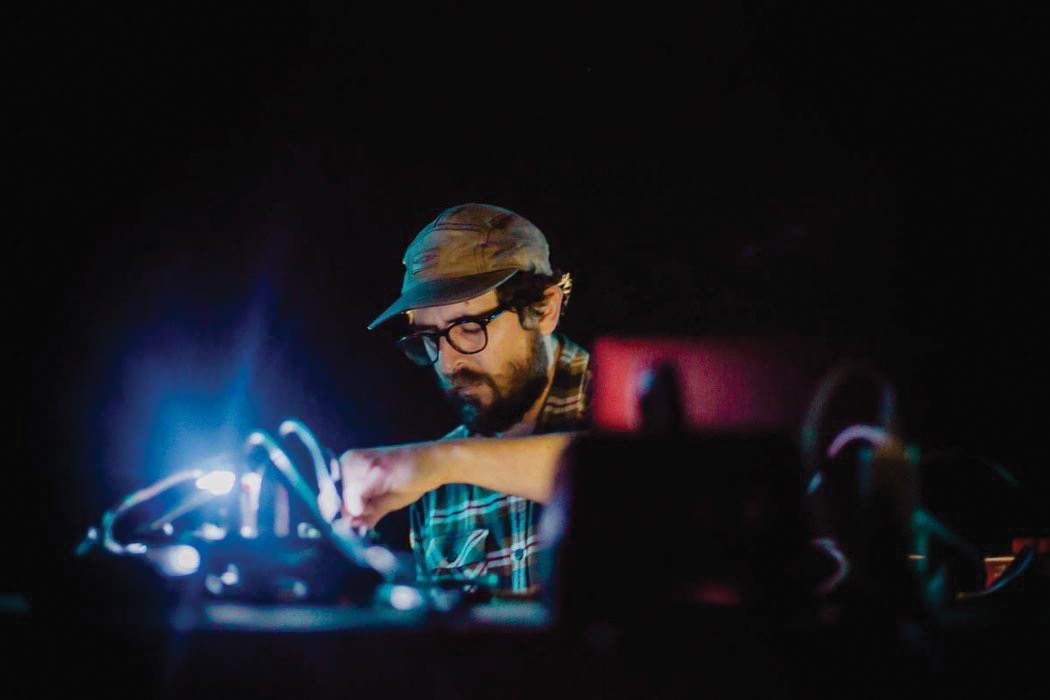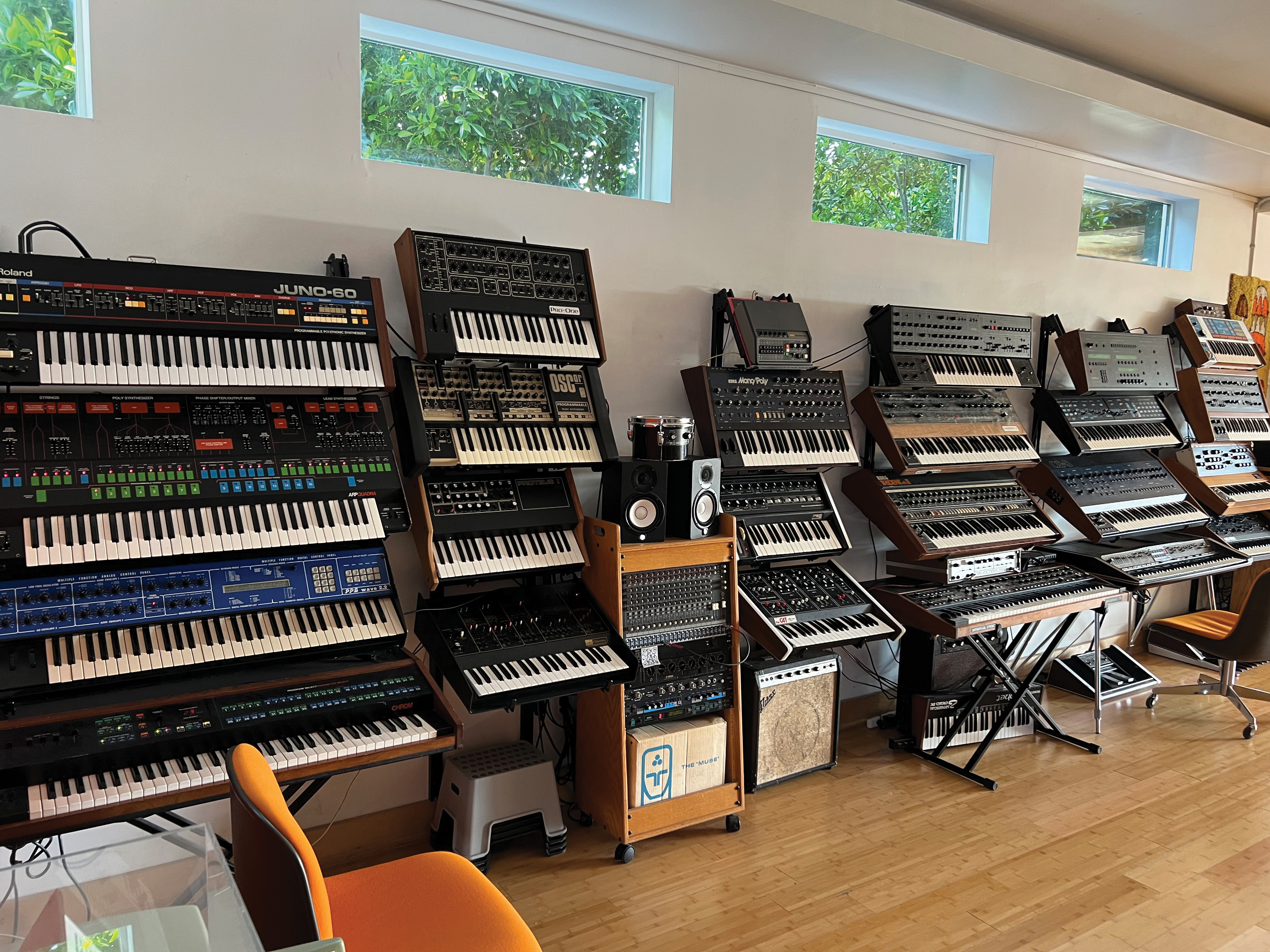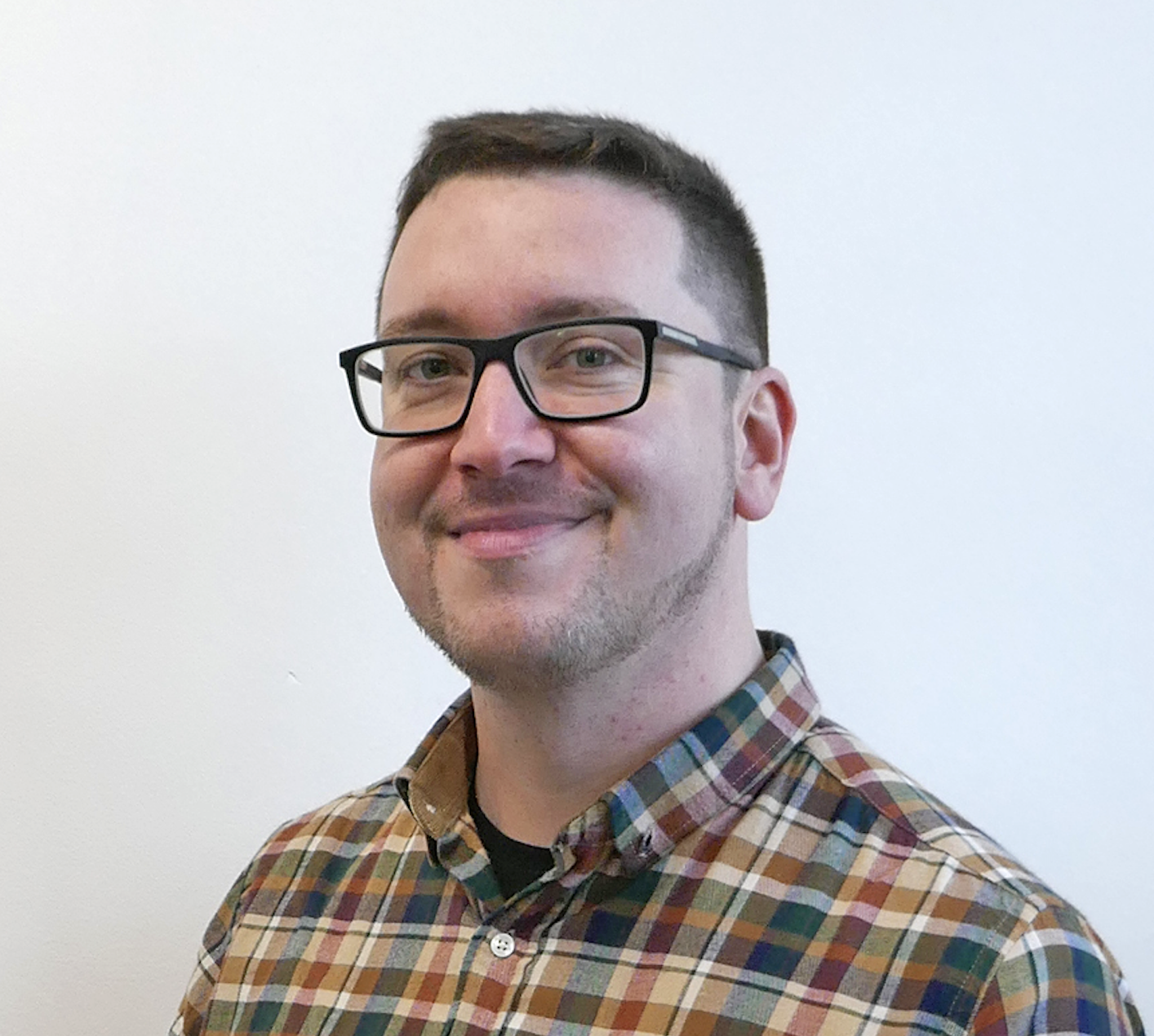Gregg Kowalsky: "I was feeding all kinds of weird stuff into Ableton's audio-to-MIDI converter. Something just clicked, and I ended up building a whole album around it"
The LA-based multi-instrumentalist and producer embraces the unpredictable chaos of generative MIDI data on new album Eso Es

Initiated by a chaotic web of MIDI data, the music that makes up multi-instrumentalist Gregg Kowalsky’s new album Eso Es represents an immersive dive into a lush and emotive array of synth sounds. For the Los Angeles-based creative, its making signalled a new approach to composition.
Those familiar with Kowalsky’s previous solo work might expect the former purveyor of meditative ambience to continue to explore the same minimalist ethos heard on 2017’s L’Orange, L’Orange, yet with his latest project, the producer embraced the unpredictable chaos of MIDI, returning to the software world of his formative years via a completely fresh creative process.
The resulting record is a captivating listen – both tranquil and messy and somehow also sprawling yet minimal. We caught up with Gregg to discover more about the process of making the record, and learn more about his journey as a restless creative.
Firstly, we really enjoyed the new record, Eso Es. It’s a really captivating, lushly produced listen. What was the starting point?
“I didn’t have one for a while and I was struggling. My last record was around five years ago. I always want to do something different so I just started playing around with an app on my iPad that was just a basic sequencer. I just started programming sequences just for fun.
“After a while I kind of liked the way that they were sounding. I ended up feeding them into Ableton Live’s audio-to-MIDI converter. That’s where everything sort of clicked. I’d never used MIDI aside from the odd track here and there. This was the first time that I really utilised MIDI data, the whole album became built around it.
“Aside from converting the sequences to MIDI, I was also feeding stuff that you probably aren’t supposed to feed into the MIDI converter. That’s always been part of my technique – utilising software in ways that it wasn’t necessarily created to do. I would feed it a Juno 106 drone pad, whereas typically you’d feed in something more distinct like a bass line. It just spat out a confusion of MIDI data that I ended up working with.”
Want all the hottest music and gear news, reviews, deals, features and more, direct to your inbox? Sign up here.
And how did you process that in the software domain?
“I used Arturia’s DX7 V soft synth to play back the data and it actually sounded really cool. That’s basically where it started. Then the fun was figuring out which patch on the DX7 to use. The really fun part was feeding all kinds of weird stuff into the audio-to-MIDI converter and seeing what it came up with. This process organically happened and presented a new way to create.
“The whole album was based on the sequencer and then the DX7. I’d stack the MIDI data together, with a different DX7 sound playing it back on each track. My previous work was drone-based and quite minimalist. This became my most active and energetic music.”

So you were creatively reacting to the madness of this MIDI data being quite random and chaotic?
“Yeah, it was in lockdown as well so I had a lot of time on my hands. Sometimes the MIDI data would have to be edited because it would spit out a wrong note here and there. I would have to figure out where the little wrong note is, amongst thousands of MIDI notes. Then I started enjoying finding the rogue notes by ear. It was a very rewarding process in the end that just sort of happened by accident.”
Why did you use the Arturia DX7 V?
“I was looking for a DX7 emulation after using an actual DX-100 on my previous record. The Arturia one blew my mind. Programming it was so user-friendly compared to an actual DX7. They very much aren’t user-friendly and they’re pretty time-consuming. The interface was amazing and that just made the process such fun. I was able to download new patches from users online. I used it all over the record.
“My favourite synth is probably the Roland Juno 106 because of its dual chorus effect. I’d seen that someone had made a guitar pedal version of it, but I applied that concept to the synth sounds I was working with and that gave it a nice wash.”
And you recorded all this in your home studio?
“Yes. I’m in Los Angeles now but during the pandemic I moved back to Miami for a while, which is where I first started making music. Computer Music magazine [MusicRadar's sister magazine] was actually a huge part of my beginning; I found the magazine at my local Borders. It was reading this very magazine where I first discovered that you could use a desktop computer to produce music. It introduced me to different plugins. It was a huge part of my beginning. So it’s really cool to talk with you now. It exposed me to so many different tools.”

We’re flattered! And pleased to hear the magazine was of service. It sounds like the creative journey of making this record allowed you to respond organically. Is that how you intend to keep writing in the future?
“This album was generated that way. I’ve never worked like that before. I definitely intend to carry on – it’s such a new process for me. All the music I make is based on some new creative process that I’ve developed. When I first started I was really into granular synthesis. I would respond in a way to what the granular synth patch would generate. The way I composed was partially composed and partially improvised. The way I would create back then is that I would record myself doing a live take with very little overdubbing.
“This album is the opposite of that, it’s MIDI, so it’s already ‘there’. Trying to figure out how to perform this live has been a bit of a challenge but I’ve come up with some interesting ways of doing that. I do like the sense of surprise and chance when I’m working.”
Which tracks took the longest to get right and how did you know when something was done?
“There are still tracks that I haven’t finished! There were two that I wanted to get on the album. It was the first time I could remember where I couldn’t figure out the best way to finish them. I could have put them on there but I realised they were a little different to the rest of the material. In terms of what’s on the album, probably the track Throwing Shapes – it’s probably the most ‘different’ track I’ve ever made.
It went from minimalism to maximalism very quickly
“It’s all percussive, but it’s all still the Arturia DX 7 V – which is not a drum machine. I was trying to edit it down from around 18 minutes; I think that’s probably why [it’s different]. It also did become the longest track. I think editing made the process take longer. A lot of these tracks were really minimal at first – I kind of liked them in that way, but it would have been a totally different concept and sound. It went from minimalism to maximalism very quickly.”
That’s a good one, it’s quite an immersive listen.
“I feel like during the pandemic, the sense of time became a little skewed. That’s sort of affected my sense of pacing of music in some ways. I didn’t have a sense of time like I have had in the past when it comes to things like pacing. I’ve never made a track like Throwing Shapes, which is based on rhythm and percussion. It’s one of those tracks that I really liked, but wasn’t sure if people would like it. So, thank you!”
Making this record was largely the result of trial and error. But, did you have an idea of the type of vibe you wanted?
“The sound of the record was a bit of an unknown. Each of my albums is different to the one before. This album had a completely different creative process as well as a completely different sound. I don’t have the reference points from my previous work so this is all new to me. I like listening to it, though.”
A lot of this record was done in the box with Ableton Live – was writing completely in the box a first for you?
“Yeah, this was the first time. It was all largely in Ableton Live. I started using it when it was on version 3. It was mainly for performing purposes. Over the years I started using it to sketch tracks. I would create loops and then I would create live mixes of these loops. I’d mix them in an improvisatory way. I would record my live mixes with it and then bounce them into Logic to work on my final mixes. This one was completely in Ableton Live. There was a little overdubbing but because the whole process was built around Ableton’s audio conversion algorithm it just made sense to use it.”

What’s on your gear wishlist?
“For around the first six years of my music production journey I was using FL Studio and granular synthesis. I started to feel that I was beholden to my laptop. The only way I could make music was with a computer. If my computer crashed at a live show that would be such an annoyance. Once I realised I could put my loops on cassette tapes – a format I grew up with – I then swung completely analogue [on second album Tape Chants]. It then became more of a performative sound installation thing.
I spent a decade focused on analogue synths, but this album is getting back to how I started - full circle!
“I’d set up different players around the space, I would tune all the cassettes to each other. I’d turn them all on and it would become a lo-fi, ambient, surround sound thing. I wanted more of a hands-on connection with the audience. It was a different way of performing and I think the audience appreciated it. I then got hooked on analogue synths, too, of course. That took me up to this album. I spent a decade focused on analogue synths and the warmer/dirtier sound. This album is getting back to how I started – full circle!”
Did you use many of Ableton Live’s stock plugins and effects, or did you rely on your own?
“I did originally, I used the Ableton EQs and reverbs. I did use Max for Live sequencers in there – I can’t recall which tracks specifically used them, but one or two were deployed. Eventually I fell in love with FabFilter’s Pro Q 3. EQing for me is something I really love doing. I think it’s super important.
“Once I got my first analogue mixer, I learned to EQ by ear from a subtractive sense. The Q 3 just really helps with that intuitive process. It’s a very easy user interface. I just ended up swapping out the Live EQ for that. I used some of Live’s utility plugins more than the creative ones.”
Are you planning on performing this record live anytime soon?
“I’m planning some shows in Europe so I’m going to do that, but I really don’t know how I’m going to play this record live! Some people will go up with their computer and hit the spacebar and nod their head. I get that completely. I probably would have been better off doing that a few times in the past. I had one time when I was performing in a dance theatre in Sweden and the lights were really hot. I was quite lazy about setting up a MIDI controller so I was using the mouse pad of my laptop. I couldn’t use the mouse anymore because I’d just sweated on it and it was all wet.
I’ve never really worked with MIDI data in this way before. It’s like having another band play my music
“In LA there’s the Vintage Synth Museum and I’m going to perform there. I realised it’s the perfect place for me to play this material. I went there last week to test it out. What I can do is send MIDI data to different synths in this studio that will accept MIDI. It’s a little overwhelming to be honest but it’s also really cool. I’ve never really worked with MIDI data in this way. It’s like having another band play my music. It’s either playing the sequences or the melodies. I have to really score it to make it work. I leave myself room to improvise, so it’s interesting to me, too.”
What are your thoughts on the encroachment of AI into the music production space?
“I haven’t worked with it. My younger self would be amazed by it. I think that when I originally heard of it I thought it would spell the end of licensing for musicians. TV shows and films would typically use licensed music from artists, but I don’t think the general public cares enough for them not to just use AI to make tracks for them.
“It’s like every other technology where I think there’s going to be benefits that are pretty exciting and cool. It’s going to take a while to know what the pros and cons are. I would use it just to have fun – because I like the idea of something just generating spontaneous ideas, I could see myself playing off that data, but I can kind of do that already now.”
What’s next on the agenda for you Gregg?
“The album was released on October 27th, so I’m doing a couple of shows around that. I haven’t really played shows in five or so years, it’ll be nice to work that muscle again. The first is the Vintage Synth Museum show I mentioned, the other is with an organisation called Feels Like Floating. They put on shows 99% of the time outdoors in beautiful locations around Los Angeles. I love playing non-traditional venues as opposed to bars and clubs. They started right before the pandemic.
“Then I’m planning on doing a European tour. Making albums is really difficult, and after I make one I feel like I need a break. In doing so I sometimes lose the momentum of making tracks. I tried hard this time to not do that. I have a couple of other releases to work on, a few singles here and there.”



I'm Andy, the Music-Making Ed here at MusicRadar. My work explores both the inner-workings of how music is made, and frequently digs into the history and development of popular music.
Previously the editor of Computer Music, my career has included editing MusicTech magazine and website and writing about music-making and listening for titles such as NME, Classic Pop, Audio Media International, Guitar.com and Uncut.
When I'm not writing about music, I'm making it. I release tracks under the name ALP.